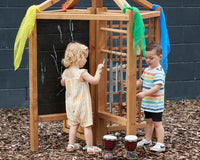Cornet vs trumpet; they are both very similar members of the brass instrument family but are generally used for different styles of music. Many advanced players will be competent on both but what exactly is the difference?
Identical Elements
Before we look at the difference, let’s first cover the basic elements of their design that are identical. Firstly, and most obviously, they are both made of the same material - brass, have 3 valves and the sound is produced on both by ‘buzzing’ your lips.
The tubing is also of an identical length (4 1/2 ft approx without valves depressed), although it is wound much tighter on a cornet giving the initial appearance that it is shorter. As they are both the same length they therefore also play at the same pitch which is Bb on standard models.
Plastic Fantastic
Over recent years we have seen the introduction of the brilliant plastic brass instruments.
Made from lightweight ABS hard (and nearly indestructible!) plastic, these offer the younger players a great and colourful fun way to get into playing the cornet or trumpet. Due to the light weight, they cause much less fatigue for the younger (or older!) player.
Cylindrical v Conical Bore
The fundamental difference between the instruments is in the shape of the bore (tubing diameter) throughout the instrument (excluding the bell flare section). On a trumpet the bore is cylindrical, having a consistent diameter throughout the instrument, whereas a cornet has a conical bore which gradually increases in size down the length of the tubing.
This makes a huge difference to the type of sound that is produced with the trumpet giving a very piercing, direct sound (think fanfares) and the cornet a warmer, softer, rounder sound (think Hovis Bread or Coronation Street!).
Bands & Ensembles
As each instrument makes a distinctively different sound they are generally used in different ensembles depending on the style/genre of music being performed. Trumpets can be found in orchestra’s, jazz, big bands and often in the ‘horn’ section of a pop/rock band.
Cornets are traditionally found in a brass band where the majority of the instruments are conical bore. However, concert and military bands generally contain both trumpets and cornets due to the wide range of wind instruments and therefore timbres found in this type of ensemble.

Younger Children
The vast majority of high brass players originally started their lessons on a cornet as it is the easiest to hold/handle from a young age. I stated above that the cornet and trumpet are the same length and pitch, but because the cornet tubing is ‘wrapped’ tighter it is more comfortable for a small child to hold. Their arms and therefore the centre of gravity of the instrument, are held closer to the body meaning that it is less tiring for the child when played for any length of time.

Is One More Popular?
In worldwide production terms trumpets outsell cornets, predominantly because the brass band is a very British ensemble and trumpets are more popular in the American market. Brass bands are starting to flourish in many other regions now though including Australia, Netherlands and Asia as well as in the USA.
Which One’s for Me?
As for which one you should choose, that’s down to your own personal musical taste. If you like rousing orchestral works or a bit of big band then the trumpet will always be your best option, but if you prefer the distinctive sound of a good old traditional British Brass Band then the cornet is the one for you.
It is worth noting that it doesn’t have to be an either/or choice, many top players will be proficient on both, although generally they will have one that is their primary instrument.




















